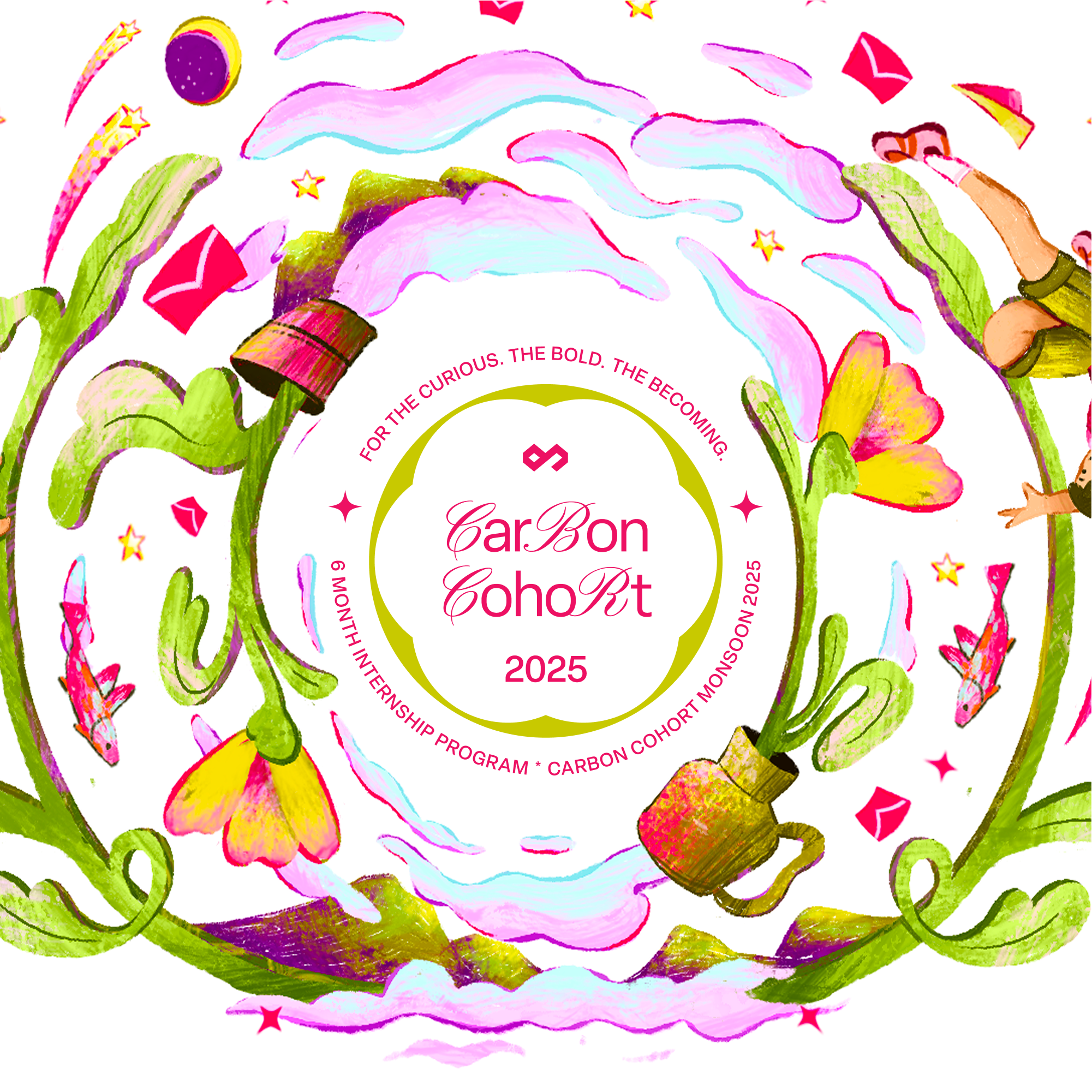Our Lowest Resolution Yet

Foldables were supposed to be the future.
They were meant to disrupt the black slab. To offer something fresh after a decade of rectangular screens and minimalist monotony. But what did we get instead? Sleeker rectangles. That fold.
Some time ago, we got the opportunity to work on this very brief as part of a client pitch. Two days, no boundaries, and one simple goal: to fall in love with a phone design again. Not its specs. Not its features, apps or the software. The phone itself.
We spent this time researching, sketching and visualizing concepts that would disrupt the mobile industry.
The pitch didn’t go forward. But the idea stayed. As it often does.
Here, we are sharing our journey of designing a unique foldable design. From the research, our insights, to the trials and all the way to the final concept development.

People and Queries
Before we sketched even a single line, we did a demographic research of the people who would be using this concept phone. Specifically the Millenials and Gen Z. We studied their behaviours, motivations and emotional responses to tech today. We wanted to understand why they buy, scroll, fidget and care.
From this, we uncovered six major insights and directions:
1. The Odd Case of Cases
Query #1: Is it not odd that a beautifully crafted device is almost always put in a case?

In a world obsessed with youth and perfection, beauty needs to be redefined. Objects, like people, age gracefully. These imperfections, like wrinkles on a face, tell stories of resilience and growth. Instead of hiding them, we can celebrate them as symbols of enduring elegance. The Japanese philosophy of “Wabi-Sabi” embraces these flaws and the natural cycle of life.
These marks aren’t decay but life experiences. So what if we embrace the beauty in these marks and wear them with pride.
Concept #1: Embrace
Imagine a phone that embodies Aging-Inspired Design. Sturdy and elegant, it withstands falls and scratches, showcasing each unique mark as aesthetic patterns. This phone evolves with time, celebrating enduring beauty through aging, a personal treasure that grows with you.
2. The Analog Dialogue
Query #2: What if touch, a primal sensorial experience makes a contemporary comeback?

Touch, a primal sense, has shaped our survival and continues to define our experiences. It’s been crucial in our evolution, fostering both technological and emotional connections. In today’s hyper-connected world, touch remains a grounding force amidst digital overload. The younger generation seeks solace in tactile experiences, from clicking pens to tapping feet. Fidgeting serves as an outlet for inner restlessness, anchoring us in the present.
We can harness this innate desire to explore touch beyond touchscreens.
Concept #2: Sensorium
Touch, a universal language, connects us to our environment and others. “Sensorium”, a smartphone concept, goes beyond flat touch screens, offering analog controls with tactile feedback. Physical knobs, sliders, and buttons rekindle the joy of touch and control, making tasks immersive, thus enhancing well-being and expression.
3. Digital Wellness
Query #3: What if your phone could facilitate your digital wellbeing?

As digital immersion becomes the norm for work, communication and entertainment, its impact on our well-being is clear. Constant screen exposure results in eye strain, disrupted sleep, heightened stress, anxiety, and depression. Social media alters societal dynamics, fueling feelings of inadequacy. Excessive phone use diminishes our relationships, creativity, and imagination. While technology brings enrichment, it erodes human connection.
Perhaps it’s time for a digital detox and intentional screen usage. What if we had a phone that helps us power down and engage in meaningful conversations?
Concept #3: Tranquil
Imagine an ethical phone: “Tranquil”. It prioritizes digital well-being with Connected and Wellness modes. The latter, on a secondary e-ink display, promotes detox, free from distractions. Tranquil offers tools like screen time tracking, focus mode, and scheduled downtime, making it effortless to balance functionality and digital wellness.
4. Material Rethink
Query #4: What if the interpretation of metal phone bodies takes a radical turn?

Traditionally, phone case manufacturing involved carving metal blocks to maintain a sleek, premium look, but it also limited creativity. This led to a flood of uniform brick-like phone designs, erasing the distinctiveness of older, plastic models. However, we can draw inspiration from the automotive industry, which continuously crafts unique and functional forms using various techniques like sheet metal bending, casting, and stamping.
Concept #4: Finesse
Imagine a revolutionary smartphone concept: “Finesse.” It redefines aesthetics and efficiency by utilizing “FinesseFrame,” which employs deep-drawn sheet metal for intricate, cost-effective designs, a departure from costly CNC milling. This innovation promises distinctive, affordable smartphones, marking a leap forward in design and production.
5. The Clear Choice
Query #5: What if we look back to trends from the past to shape the future?

Design trends have evolved with changing tastes and technologies, and one trend making a comeback is the use of transparent materials. This choice reflects innovation, nostalgia and a desire for authenticity. Iconic products like the Sony Walkman once used transparency to highlight form and function, fostering curiosity. This aesthetic was overshadowed by minimalism and metallic finishes, but recent manufacturing advancements have again enabled intricate transparent components.
Transparency aligns with the demand for honest, open products, resonating with consumers’ values. The resurgence of such aesthetics is likely to endure in this decade.
Concept #5: Prisma
“Prisma” redefines smartphone aesthetics by embracing transparency. Its unique design philosophy is simple. We have nothing to hide, and we are proud of who we are. The robust, shatter-resistant glass body showcases the phone’s inner workings, demystifying technology. Prisma is a fashion statement, conversation starter, and cutting-edge device all in one.
6. The Pixel Matrix
Query #6: What if your phone is as emotive as your human friends?

Pixel aesthetics originated in the digital age, notably during the 8-bit and 16-bit gaming eras. Technical constraints birthed low pixel density, which now evokes nostalgia among the new generations. This generation raised on pixelated video games seeks the simplicity and charm of these early visuals, leading to their resurgence in contemporary art, illustration, animation and design. Pixel aesthetics thrive on limitations, challenging artists to convey depth and detail with simplicity, resulting in intricate yet straightforward visuals.
Artists have honed this art of concise expression for decades, making pixels a potent tool for minimalistic communication.
Concept #6: Mosaic
“Mosaic”, a dual-screen phone, elevates communication beyond words with its innovative pixel screen on the back. It enables expressive messages, emotions and creativity through dynamic visuals. Whether conveying love, humor, or memes, Mosaic adapts to your mood, weather, and music, doubling as a discreet notification screen. Personalize and be unique.
Some other What-ifs that we explored as well:
- What if a part of the phone never dies?
- What if mobile phone becomes family heirloom?
- What if smartphone never runs out of battery?
- What if smartphones are the ultimate personal entertainment hub ?
- What if smartphone helps in managing your anxiety?
- What if modularity for phones was relooked at from the perspective of a democratised system?
Eventually, we asked: What if we combined the best of these concepts?
And that’s how Voxel was born.
Retro Tech Revival

Voxel was designed to be a foldable that blends retro personality with modern needs. With an instantly recognizable form and look, Voxel invites onlookers to pick it up and play. We intended for this concept to not be a product governed by specs, but one with a character. A device that lets you play, pause and connect on your own terms.
The Grid That Made Us Smile
We spent hours playing with pixel grids. Which one is the best?

Too small, and it lost charm. Too big and the screen became unreadable. After multiple iterations, we found the sweet spot. A 28 × 23 pixel grid. It was just enough to show a heart, a smiley or a weather icon.
Not enough for distraction, but perfect for delight.


Inspired from the “Mosaic” concept, this grid became the canvas. The face. The emotion engine of the phone.
Fold to Disconnect
Although the brief required us to design a foldable phone, we didn’t want it to be just another cool feature. We wanted it to mean something. Like how the old flip phones had a personality of their own when flipped open or slammed shut. For us, the folded form was philosophical.
So we took inspiration from the “Tranquil” concept for this feature of Voxel.

When open, the Voxel acts just like your normal phone, with all the latest tech and features. But the when folded, Voxel becomes a dumbphone. No apps. No doomscroll. You can interact with all the important stuff right from its pixel screen, without the need to open it. It let’s you pick up phone calls, skip songs, check the time, check how long until your food arrives or even play retro pixel games!
And when open, it becomes smart again.
The physical action of folding becomes symbolic. A way to switch modes.
From chaos to pause. From doing to being.
A Scroll that Grounds You
Remember the iPod click wheel? The smooth and intuitive interaction was what made the iPod iconic. It was a tactile experience like no other. So we brought it back!

When folded, a circular, tactile ring near the thumb acts as a versatile navigation tool that lets you spin, scroll and select. We designed it to be placed right within the reach of the thumb, so you don’t have to do finger yoga.
Inspired from the “Sensorium” concept, this button intended to bring back the kind of analog joy we’ve lost in the swipe age.
Nothing to Hide
We designed the back of Voxel to be transparent. Not to be flashy, but to be honest. We realised that the new generations prefer authenticity and honesty, and for us, a transparent back was a beautiful metaphor for the same.

Inspired from the “Prisma” concept, the transparent back cover reveals the internal workings of the Voxel in all their glory. The magnetic coil, the circuits, the skeleton. Because we wanted to have a phone that was authentic, with nothing to hide.

Additionally, we conceptualised two variants of the phone, one with a subtle grey and another with a loud accent colour. You can choose which one you resonate more with as a personality.
Closing Thoughts
This design sprint reminded us that good design doesn’t always add. Sometimes, it subtracts. And that’s the kind of future we want to feel more of. Not louder, but wiser. Not faster, but more intentional.

When we were working on the phone concept, we approached it like a thought experiment. We wished to create something that helped us explore the things we missed in today’s tech. All the while having a unique character, that makes you use the phone as it is. Show it off, without covering it up.
Currently, foldable phones open up to reveal more pixels, and increase a barrage of information and cognitive load. We wanted to create a foldable phone that folds to reduce the same. Why?
Maybe because in a world of infinite scrolling, we all need a fold.









